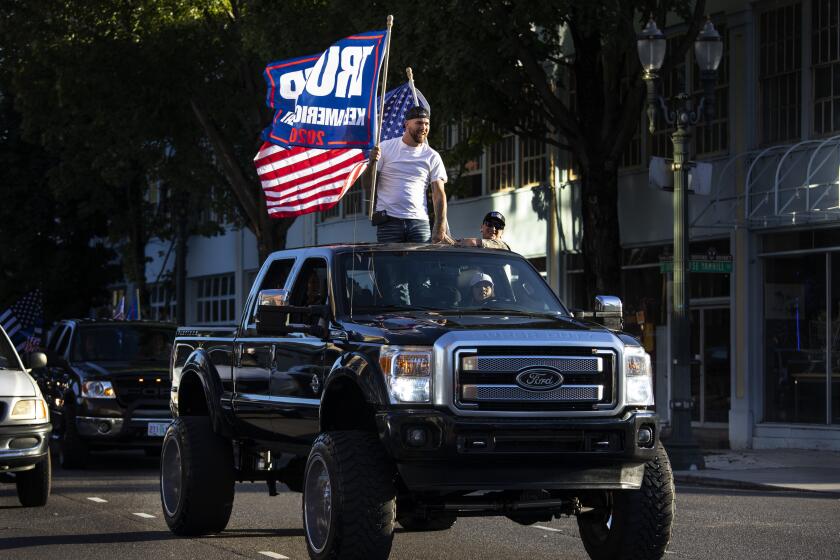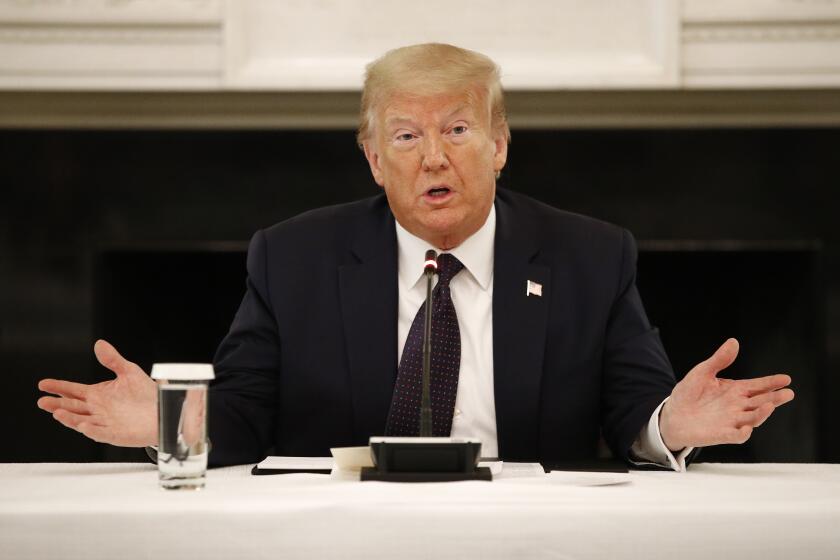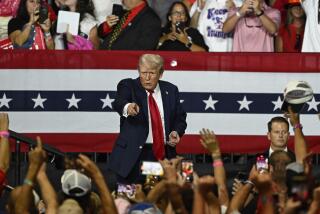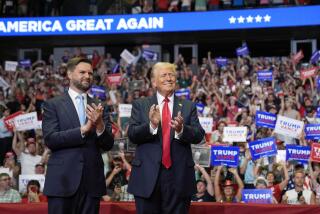Biden hits Trump on urban unrest: ‘Fires are burning and we have a president who fans the flames.’

WASHINGTON — A week before the traditional Labor Day kickoff, President Trump and former Vice President Joe Biden plunged into the fall campaign’s homestretch Monday with a bitter duel over racism and violence, casting the general election as a referendum on who would keep America safer as well as on Trump’s record in office.
Trump will intensify his focus on urban violence Tuesday, when he plans to visit Kenosha, Wis., ignoring pleas from Gov. Tony Evers, a Democrat, and local officials that he stay away. The city has become a flashpoint in the nation’s unrest as it struggles with protests over the police shooting of Jacob Blake, a 29-year-old Black man.
For his part, Biden flew to Pittsburgh on his longest campaign trip since the pandemic stopped most of his in-person campaign operations last spring. In a forceful speech, the Democratic nominee accused Trump of deliberately fomenting violence with racially charged rhetoric to draw frightened voters to his side.
“Fires are burning and we have a president who fans the flames rather than fighting the flames,” Biden said. “Donald Trump looks at this violence and he sees a political lifeline.
“He may believe mouthing the words ‘law and order’ makes him strong, but his failure to call on his own supporters to stop acting as an armed militia in this country shows you how weak he is,“ said Biden. “Does anyone believe there will be less violence in America if Donald Trump is reelected?”
With the Democratic and Republican conventions now over, the speech marked Biden’s highest-profile effort to flip the script on Trump’s claims that a summer of mostly peaceful protests around the country, marred by scattered vandalism and violence, offers a dark preview of what the president called “Biden’s America.”
In a news conference a few hours after Biden’s speech, Trump again portrayed the former vice president as a tool of the Democrats’ left wing who refused to denounce violent protesters.
“The rioters and Joe Biden are both on the side of the radical left,” Trump said. “Biden is using Mafia talking points: The mob will leave you alone if you give them what they want.”
Biden in his speech scoffed at the effort to portray him as a left-wing radical, and repeated his frequent denunciation of violence and vandalism.
“Ask yourself, do I look like a radical socialist with a soft spot for rioters? Really?” he said.
“I want to make it absolutely clear, so be very clear about all this: Rioting is not protesting. Looting is not protesting. Setting fires is not protesting. None of this is protesting. It’s lawlessness, plain and simple.”
Trump refused to condemn his own supporters, including Kyle Rittenhouse, the 17-year-old charged with shooting and killing two protesters in Kenosha last week, saying the youth looked as if he was responding to being under attack.
Weeks of rising tensions and occasional clashes between pro-Trump groups and protesters in Portland, Ore., erupted in gunfire on Saturday night, leaving a local counter-protester dead. No one has been charged in the killing.
Trump brushed off concerns that his visit to Kenosha on Tuesday would heighten tensions in the volatile environment. The president said he had spoken to Jacob Blake’s family’s pastor but would not talk to the family because they wanted lawyers present.
But in an interview on CNN, Blake’s father said, “We don’t have a family pastor...I don’t know who he’s talking to.”
The sharp Trump-Biden byplay offered a foretaste of what could dominate the final nine weeks of the race.
Republicans will try to focus on “law and order” because they believe the issue appeals to voters concerned about violence spreading to their communities — especially in suburban areas that are key to the election outcome.
Democrats will try to shift voters’ attention back to what they contend is Trump’s mismanagement of the coronavirus crisis and his efforts to dodge responsibility for the growing turmoil in the country he leads.
Biden’s speech came the same day that the COVID-19 pandemic passed another awful milestone: The U.S. tally of positive cases hit 6 million, far more than any other country, and more than 183,000 deaths.
“Mr. Trump, want to talk about fear?” Biden asked, speaking in a pivotal swing state but only to a small group of socially distanced reporters who traveled with him. “You know what people are afraid of in America? They’re afraid they’re going to get COVID. They’re afraid they’re going to get sick and die. And that is no small part because of you.”
The last week has underscored how much the final stages of the 2020 presidential campaign will be buffeted by unpredictable events as well as steered by carefully calibrated campaign strategy.
The Biden campaign had hoped to keep their focus on the Trump’s handling of the coronavirus contagion and double-digit unemployment, which they see as a political millstone for an unpopular president.
But Trump’s relentless tweets and speakers at the Republican National Convention last week helped move the campaign’s focus to Kenosha, and Portland.
Biden responded Monday with a clear pivot, shifting the focus from street violence to a broader array of calamities that have erupted on Trump’s watch, from a recession to a rising homicide rate to unsettled international affairs.
“We are facing multiple crises — crises that, under Donald Trump, keep multiplying,” Biden said. “COVID. Economic devastation. Unwarranted police violence. Emboldened white nationalists. A reckoning on race. Declining faith in a bright American future. The common thread? An incumbent president who makes things worse, not better.”
Trump hopes violence at protests will generate a backlash against Democrats; opponents accuse him of inciting more violence with his rhetoric.
Biden’s trip to Pittsburgh suggested that Trump’s constant taunting of him as huddling in his basement was beginning to take a toll, as Democrats have urged him to venture out more. He has mostly stayed at his home in Wilmington, Del., because of public health guidance about how to prevent and protect against the spread of COVID-19.
He flew to Houston in June to meet privately with the family of George Floyd, the Black man who died at the hands of police in Minneapolis. He also traveled to Washington, D.C., in July to pay tribute to the late Rep. John Lewis.
How to reshape the nation’s police forces has become a major campaign issue. President Trump hopes to portray Joe Biden as extreme.
He said last week that he will start visiting Wisconsin, Minnesota, Arizona, Pennsylvania and other battleground states after Labor Day for events that are consistent with the public-health guidelines of the communities he visits.
He made an unannounced stop after his speech Monday to deliver a few pizzas to Pittsburgh Firefighters Local 1. Wearing a mask the entire time, he spoke briefly with the firefighters and posed for a group photo.
“I was worried my staff was going to keep them,” Biden said of the pizzas.
Times staff writers Noah Bierman and Chris Megerian contributed to this report.
More to Read
Get the L.A. Times Politics newsletter
Deeply reported insights into legislation, politics and policy from Sacramento, Washington and beyond. In your inbox three times per week.
You may occasionally receive promotional content from the Los Angeles Times.













